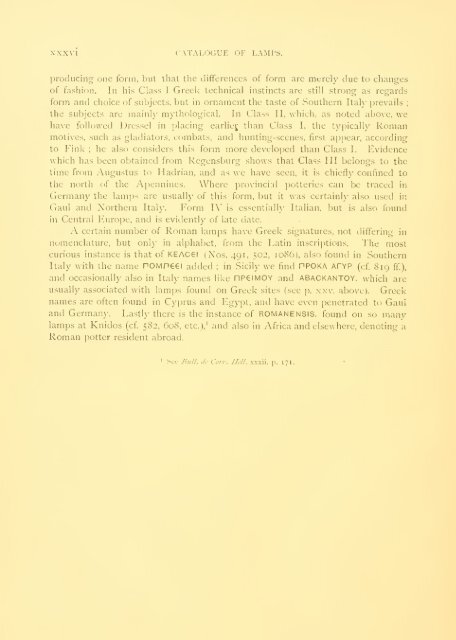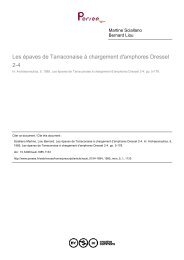- Page 1 and 2: g'Ji... ^_ *:; mm:.-: 'mf/'''.f^-''
- Page 5 and 6: CATALOGUE Of THE GREEK AND ROMAN LA
- Page 7: PREFACE. The present Catalogue deal
- Page 10 and 11: VI TABLE OF CONTENTS. 7. Lamps with
- Page 13 and 14: LIST OF LAMPS ILLUSTRATED ON PLATES
- Page 15 and 16: NTRODUCTION. The lamps described in
- Page 17 and 18: INTRODUCTION. Mil It is probable th
- Page 19 and 20: INTKUDUCTION. XV Lamps were used fo
- Page 21 and 22: INTRODUCTION. WTl of ornament on th
- Page 23 and 24: interior ; there IXTRODL'CTION. xlx
- Page 25 and 26: INTRODUCTION. . X\l The varieties w
- Page 27 and 28: INTRODUCTIUX. XXUl lamp. The blunt-
- Page 29 and 30: INTRODUCTION. found with coins of A
- Page 31 and 32: INTRODUCTION. XXVI or such figures
- Page 33 and 34: IXTRODUCTIOX. XXIX lleraklcs; four
- Page 35 and 36: INTRODUCTION. XXXl dagger, and a la
- Page 37 and 38: INTRODUCTION. XXXlli lamps, especia
- Page 39: INTRODUCTION. XXXV rc|)re.sented at
- Page 43 and 44: LIST OK
- Page 45 and 46: CATALOGUE OF LAMPS. Note.—The lam
- Page 47 and 48: BRONZE LAMPS. 3 8. In form of head
- Page 49 and 50: lamp. Nozzle at chin, with row of b
- Page 51 and 52: onzp: lamps. 7 shaped riin, and a s
- Page 53 and 54: BRONZE Lx\MPS. 9 42. Similar. Lengt
- Page 55 and 56: 57. Length 6 in. Variety of precedi
- Page 57 and 58: BRONZE LAMPS. 13 68. Similar. Lengt
- Page 59 and 60: BRONZE I, AMI';;. 15 (5) TYPE WITH
- Page 61 and 62: 98. Form No. 7. Lenyth 5^ in. Caste
- Page 63 and 64: 111. 112. 113. 114. 115. 116. 117.
- Page 65 and 66: 123. Siiiiilai. Length 9 in. From W
- Page 67 and 68: 128. STONE LAMP. Length 3,5 in. Ht.
- Page 69 and 70: CRAECO-PHOKNICIAN LAMPS. 25 136. Va
- Page 71 and 72: GREEK LAMPS. 154. Simil.ir. Diatn.
- Page 73 and 74: 169. I'unn No. 11). Diam. 2: in. Kn
- Page 75 and 76: GREEK LAMPS 3I 192. Similar. Length
- Page 77 and 78: 219. 220. GREEK LAMPS. ^^ Similar.
- Page 79 and 80: f;Rp;EK LAMPS. 35 239. Similar. Len
- Page 81 and 82: GREEK LAMI'S. 37 260. Form No. 41.
- Page 83 and 84: 274. LengllMlin. Naples, 1847. 275.
- Page 85 and 86: GREEK LAMI'S. 4 289. Similar. Lengt
- Page 87 and 88: 305. 306. 307. 308. 309. 310. 311.
- Page 89 and 90: tiREKK LAMPS. 45 317. Similar. Leng
- Page 91 and 92:
(RKI'.K LAMPS. 4; 327. Similar. Lei
- Page 93 and 94:
341. 342. 343. 344. 345. 346. GREEK
- Page 95 and 96:
354. Similar. Length 5;J in. Diam.
- Page 97 and 98:
376. .Siinil:ir. Length 5 i in. Dia
- Page 99 and 100:
ROMAN LAMl'S. 55 IV. ROMAN LAMPS (3
- Page 101 and 102:
ROMAN LAMPS. 57 393. Similar. Lonai
- Page 103 and 104:
405. 406. ROMAN LAMI'S. 59 In form
- Page 105 and 106:
419. 420. 421. 422. 423. 424. ROMAN
- Page 107 and 108:
nozzles ; head wanting ; wings ROMA
- Page 109 and 110:
ROMAN LAMPS. 65 445. Form No. 62. D
- Page 111 and 112:
ROMAN LAMrS. 67 design. On the top
- Page 113 and 114:
side a wreath with berries ; betwee
- Page 115 and 116:
478. 479. 480. 481. 482. 483. ROMAN
- Page 117 and 118:
ROMAN LAMPS. 73 487. Length 2^ in.
- Page 119 and 120:
500. 501. 502. 503. 504. 505. 506.
- Page 121 and 122:
512. 513. 514. 515. 516. 517. Simil
- Page 123 and 124:
ROMAN LAMPS. 79 523. Similar. Lengt
- Page 125 and 126:
532. Length 4 in. Diam. 3 in. From
- Page 127 and 128:
546. 547. ROMAN LAMPS. 83 front wit
- Page 129 and 130:
ROMAN LAMrS. 85 557. Length 4; in.
- Page 131 and 132:
569. Length 4s in. Diam. purchased
- Page 133 and 134:
ROMAN LAMPS 89 582. Length 3] in. D
- Page 135 and 136:
ROMAN LAMPS. 599. Length 3I in. Dia
- Page 137 and 138:
615. Similar. Diam. 3i in. From Dam
- Page 139 and 140:
627. 628. 629. ROMAN LAMPS. 95 arca
- Page 141 and 142:
ROMAN LAMPS. 97 637. Length 41 in.
- Page 143 and 144:
653. 654. 655. 656. ROMAN LAMPS. 99
- Page 145 and 146:
to Greek and Roman Department, p. 2
- Page 147 and 148:
672. Length 4J Urown glaze. ROMAN L
- Page 149 and 150:
687. 688. 689. 690. ROMAN LAMPS. 10
- Page 151 and 152:
ROMAN LAMPS. 704. Length 4 in. Diam
- Page 153 and 154:
724. Length 4s ROMAN LAMPS. 109 in.
- Page 155 and 156:
737. 738. 739. 740. 741. 742. 743.
- Page 157 and 158:
ROMAN LAMI'S. I 750. FRAGMENT OF LA
- Page 159 and 160:
759. 760. 761. 762. 763. 764. 765.
- Page 161 and 162:
ROMAN LAMPS. 117 773. Form No. 84 (
- Page 163 and 164:
ROMAN LAMPS. I IQ 782 783. Two simi
- Page 165 and 166:
ROMAN I, AMI'S. 801. Length 4 in. D
- Page 167 and 168:
813. 814. 815. 816. 817. 818. 819.
- Page 169 and 170:
Oil the attachment to the handle is
- Page 171 and 172:
835. 836. 837. 838. 839. 840. 841.
- Page 173 and 174:
849. 850. 851. 852. 853. ROMAN LAMP
- Page 175 and 176:
864. 865. 866. 867. 868. hanging ov
- Page 177 and 178:
ROMAN LAMPS. 873. FRAGMENT of 'New
- Page 179 and 180:
ROMAN LAMPS. 135 883. FRAGMENT OF L
- Page 181 and 182:
ROMAN [.AMI'S. 137 897. Similar. Le
- Page 183 and 184:
ROMAN LAMPS. 139 911. Similar. Leng
- Page 185 and 186:
ROMAN LAMl'S. 141 928. Length 3i in
- Page 187 and 188:
946. 947. 948. 949. 950. 951. Lengt
- Page 189 and 190:
ROMAN LAMPS. 145 958. FRAGMENT OF L
- Page 191 and 192:
972. Length 5 in. Diam. 3] in. Blac
- Page 193 and 194:
ROMAN LAMPS. 149 986. Length 4J in.
- Page 195 and 196:
1004. 1005. 1006. 1007. 1008. 1009.
- Page 197 and 198:
ROMAN LAMPS. ^5 1020. Ht. 6i in. Fr
- Page 199 and 200:
ROMAN LAMPS. 155 palm-branch in 1.
- Page 201 and 202:
1051. 1052. 1053. 1054. ROMAN LAMPS
- Page 203 and 204:
ROMAN LAMPS. 159 1061. Length 6 in.
- Page 205 and 206:
1069. 1070. 1071. 1072. 1073. 1074.
- Page 207 and 208:
1085. . Similar. ROMAN LAMPS. l6' L
- Page 209 and 210:
Roman lamps 16 = 1099. .Similar. Le
- Page 211 and 212:
ROMAN LAMPS. 167 1107. Variant of F
- Page 213 and 214:
ROMAN LAMPS. 1117. Length 3; in. Ui
- Page 215 and 216:
ROMAN" LAMPS. 1129. Length 3J in. D
- Page 217 and 218:
1141. 1142. 1143. 1144. 1145. 1146.
- Page 219 and 220:
ROMAN LAMPS. I 75 1157. Length 4^ i
- Page 221 and 222:
ROMAN LAMPS. // 1173. Length 4} in.
- Page 223 and 224:
ROMAN LA'MPS. 179 u-ear short chito
- Page 225 and 226:
1199. Variant of Form No. lOO. Leng
- Page 227 and 228:
1208. 1209. 1210. 1211. 1212. 1213.
- Page 229 and 230:
1219. 1220. 1221. 1222. 1223. 1224.
- Page 231 and 232:
1230. 1231. 1232. 1233. 1234. 1235.
- Page 233 and 234:
ROMAN LAMPS. 189 1244. Length 3I in
- Page 235 and 236:
1261. ROMAN LAMI'S. 191 (2) Nozzle
- Page 237 and 238:
127'; 1278. 1279. 1280. 1281. 1282.
- Page 239 and 240:
1293. Form No. 105. Length 35 in. D
- Page 241 and 242:
ROMAN I.AMl'S. 19; 1311. Variant of
- Page 243 and 244:
ROMAN I,AMr'S. wreath (?) placed sl
- Page 245 and 246:
UO.Nr.KN LAMPS. 20I 1339. Length 3]
- Page 247 and 248:
1352. 1353. 1354. 1355. 1356. ROMAN
- Page 249 and 250:
1365. 1366. 1367. KdMAN LAMI'S. 205
- Page 251 and 252:
1376. 1377. 1378. 1379. 1380. R(),\
- Page 253 and 254:
on the 1. looks down, with arms fol
- Page 255 and 256:
MISCELLANKOUS OHJECTS. 21 I V. MISC
- Page 257 and 258:
1402. 1403. 1404. 1405. 1406. 1407.
- Page 259 and 260:
1414. 1415. 1416. 1417. 1418. MISCE
- Page 261 and 262:
MISCKI.I.ANKOUS OBJECTS. 217 3. LAM
- Page 263 and 264:
MISCELLANEOUS OBIECTS. 4. lamp-fill
- Page 265 and 266:
1457. Similar. Leiiglh 3J: in. Pres
- Page 267 and 268:
ADDENDA. 1474. Type as No. 175 (For
- Page 269 and 270:
ADDENDA. 225 1495. L.-VNTEKN, as No
- Page 271:
ADDENDA. 1506. FICTILE LAMP. Form N
- Page 274 and 275:
2.^,0 CATALOGUE OK LAMPS. I-'avkrsh
- Page 276 and 277:
acwnthus, 883, s84. Achilles, 876,
- Page 278 and 279:
234 CATAI,0(.;UE OF I.A.MI'S. serpe
- Page 280 and 281:
^36 CATAI,OC;UK UF LAMPS. Negro, he
- Page 282 and 283:
238 in._INDEX OF INSCRIPTIONS. A, 3
- Page 284:
HO CATALOGUE OF LAMPS. L. FABRI HIR
- Page 289:
35 ROMAN BRONZE LAMP FROM PARIS. Pl
- Page 295:
_l UJ N z o CD Z < O cr U- O en LLl
- Page 303:
390 ROMAN CLAY LAMP IN FORM OF SHIP
- Page 307:
O w 3 O cc < > Q UJ _l _l LU Q o 05
- Page 311:
y. ^ ^ %fr in u ^"i m m V #
- Page 315:
527 661 ^'r 595 679 Plate XVI. ROMA
- Page 319:
Pi
- Page 325:
^S^\^ ^ CO CD
- Page 331:
'A w < ^^:^ 'X /O; # ^ ^ ^ q: I o q
- Page 337:
I- oc I o DC UJ >cc Iz LU O Ico oc
- Page 341:
Plate XXIX. ROMAN LAMPS WITH PLAIN
- Page 345:
PLAti^KXXI. ROMAN LAMPS WITH PLAIN
- Page 353:
X w < Ph V ^ >^ •^W^foj ' N**
- Page 357:
Plate XXXVII. BRONZE LANTERNS MOULD
- Page 361:
SHAPES OF GREEK LAMPS (FIFTH-FOURTH
- Page 365:
SHAPES OF ROMAN LAMPS (VARIOUS PERI
- Page 369:
SHAPES OF ROMAN LAMPS (FIRST THIRD
- Page 372:
'i "'1^~ '!)* ,'"'"'' ---i^ii.H^-.-




